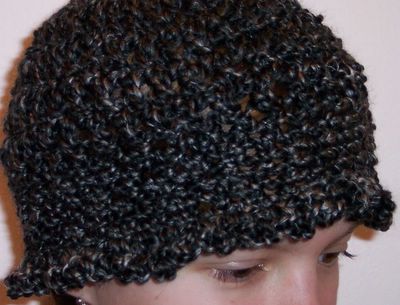To crochet a circle, you need to increase each round. If your shape buckles, you're crocheting too tightly. In that case, you might try a larger hook.
I'm going to use sc in this suggested pattern, but you can use hdc, dc, whatever. If you use hdc or dc, you need to chain a few more for your starting ring and work a few more stitches in the first round, but this is the basic idea here. In this pattern, I suggest joining at the end of each round. As an alternative, you can work continuously, making a spiral. In that case, don't ch 1 at the beginning of each round, and do be sure to mark your first stitch in each round. I use small safety pins to mark my stitches.
***********
Chain 3, join with a sl st into the 3rd chain from the hook.
Round 1: ch 1, work 6 sc into the ring, join with a sl st. (6 st)
Round 2: ch 1, work 2 sc into each st, join with a sl st. (12 st)
Round 3: ch 1, (sc in next st, 2 sc in next st) repeat around, join with a sl st. (18 st)
Round 4: ch 1, (sc in next 2 st, 2 sc in next st) repeat around, join with a sl st. (24 st)
Round 5: ch 1, (sc in next 3 st, 2 sc in next st) repeat around, join with a sl st. (30 st)
Round 6: ch 1, (sc in next 4 st, 2 sc in next st) repeat around, join with a sl st. (36 st)
etc.
Each round you increase 6 stitches.
***********
Worked in this manner, your increases will all be in the same place and you'll end up with a six-sided shape, which isn't really a circle. If you can pay enough attention to what you're doing, you can space the increases (2 sc in next st) differently on each round, and your shape will be more like a circle. For example, in round 5, instead of working (sc in next 3 st, 2 sc in next st), you might work (sc in next st, 2 sc in next st, sc in next 2 st) around. The part in the parentheses still makes 5 stitches either way, but it just puts the increase in a different place.
Another way to get a more circular shape is to start with more stitches in the ring. For example, you might chain 6, join with a sl st; then chain 3 and work 11 dc in the ring, which would give you 12 stitches in the ring (the chain 3 counts as your first dc). Then each round you'd increase 12 stitches. This will give you a twelve-sided shape, which also isn't really a circle, but it's closer to a circle than a six-sided shape is. And if you space those 12 increases out differently each round, that will make your shape even more circular.
***********
Here's the generic pattern, where:
•N is the number of chains to make the beginning ring;
•Y is the number of chains for the first stitch of each round (ch 1 for sc, ch 2 for hdc, ch 3 for dc);
•X is the number of stitches you crochet into the ring in the first round.
Chain N, join with a sl st into the Nth chain from the hook.
Round 1: ch Y, work X stitches into the ring, join with a sl st. (X st)
Round 2: ch Y, work 2 stitches into each st, join with a sl st. (2X st)
Round 3: ch Y, (stitch in next st, 2 stitch in next st) repeat around, join with a sl st. (3X st)
Round 4: ch Y, (stitch in next 2 st, 2 stitch in next st) repeat around, join with a sl st. (4X st)
Round 5: ch Y, (stitch in next 3 st, 2 stitch in next st) repeat around, join with a sl st. (5X st)
Round 6: ch Y, (stitch in next 4 st, 2 stitch in next st) repeat around, join with a sl st. (6X st)
etc.
Each round you increase X stitches.
***********
To make a hat, you start with a circle. Once the circle fits the top of your head, you stop increasing each round, and instead you crochet even. The shape will turn on itself, becoming a hat. I leave a stitch marker in the first stitch of the last round that I increase. This way, if I decide the hat is too tight, I can rip back to that point and work another round of increases.
I'm almost finished making hats, and then I'll post some pictures and links to patterns.










